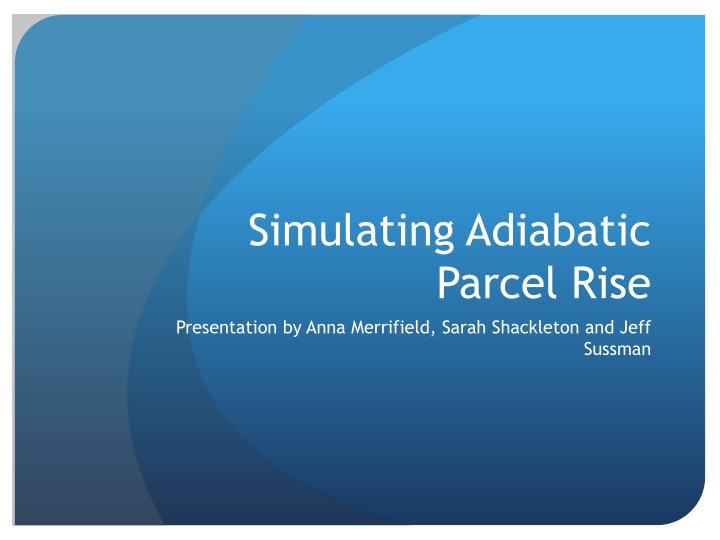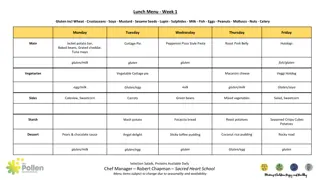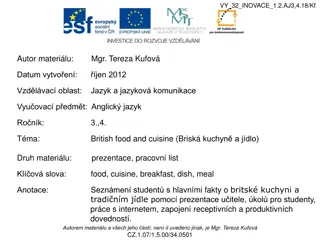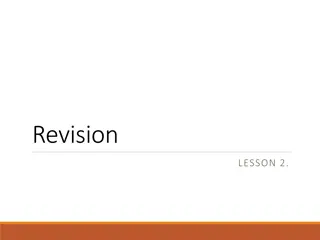
Simulating Adiabatic Parcel Rise
Explore the concept of adiabatic parcel rise in the atmosphere through informative visuals and explanations. Learn about the relationship between parcel density, atmospheric density, buoyancy force, and real-world examples of cloud formation. Discover the role of Convective Available Potential Energy (CAPE) and different methods of modeling parcel temperature. Dive into data acquisition and sensitivity analysis techniques for atmospheric modeling.
Download Presentation

Please find below an Image/Link to download the presentation.
The content on the website is provided AS IS for your information and personal use only. It may not be sold, licensed, or shared on other websites without obtaining consent from the author. If you encounter any issues during the download, it is possible that the publisher has removed the file from their server.
You are allowed to download the files provided on this website for personal or commercial use, subject to the condition that they are used lawfully. All files are the property of their respective owners.
The content on the website is provided AS IS for your information and personal use only. It may not be sold, licensed, or shared on other websites without obtaining consent from the author.
E N D
Presentation Transcript
Simulating Adiabatic Parcel Rise Presentation by Anna Merrifield, Sarah Shackleton and Jeff Sussman
Buoyancy Force Relationship of parcel density to atmospheric density At a given pressure, density is determined by Temperature
Buoyancy Force If the parcel is less dense (warmer) than the atmosphere it will rise adiabatically and cool T > Tenv If parcel is more dense (cooler) than the environment it will sink adiabatically and warm T < Tenv
Real World Examples of Parcel Rise Cloud formation If the environment is stable, clouds that form will be shallow (stratus clouds) In an unstable environment, vertical motion occurs, cumulus and cumulonimbus form Thunderstorms/Tornadoes With enough parcel rise, thunderstorms can form
CAPE Convective available potential energy Amount of potential energy available for parcel rise Important for thunderstorm growth/formation
Parcel Method 1. The parcel does not mix with the surrounding environment 2. The parcel does not disturb its environment 3. The pressure of the parcel adjusts instantaneously to its environment 4. The parcel moves isentropically
The Model 1. Obtain the data from Figure 7.2 using DataThief 2. Determine Z(P,T) 3. Model Parcel Temperature assuming: 1. Dry adiabatic rise to LCL 2. Saturated adiabatic rise to LNB 3. Moist adiabatic rise above the LNB 4. Model Parcel Temperature assuming: 1. Dry adiabatic rise to LCL 2. Saturated adiabatic rise while entraining dry air to LNB 3. Moist adiabatic rise above the LNB 5. Sensitivity analysis: find lapse rates that reproduce the model
1. Obtaining the Data The plot lines were redrawn in color to allow for effective tracing. Markers indicate the axes and the beginning, color, and end of the line we want to trace. After the line is traced, the program picks points on the line and the data can be output and read into Matlab.
1. Problems with DataThief Solution: Rather than throwing out points (they aren t bad , we determined Z using a linear least-squares fit to 3 regions of constant lapse rate
2. Determining Z(P,T) = .64 K/Km = 3.6 K/Km Regions of ~Constant Lapse Rate = 6.5 K/Km
Dry & Saturated Adiabatic Lapse Rates Dry lapse rate: assumptions ideal gas, atmosphere is in hydrostatic equilibrium, no water vapor Saturated lapse rate: assumptions no loss of water through precipitation, only liquid and vapor phases, system at chemical equilibrium, and heat capacities of liquid and water vapor are negligible, parcel has reached 100% relative humidity
Modeling Saturated Adiabatic Rise 2. Calculate ws (1) 3. Calculate s(1) which depends on ws(1),Tparcel(1) 1. Initialize esat(1), Tparcel (1) 6. Return to start of loop, calculate ws(2) etc. 4. Calculate Tparcel(2) 5. Calculate esat(2)
3. Model Parcel Temperature (No Entrainment) LNB to LCL at LCL 9.8 K/Km 5 K/Km LCL at LNB 7.5 K/Km above LNB 3 K/Km
The Second Model Entrainment: The mixing of the rising air parcel with the surrounding environment Entrainment rate: 1/m dm/dz Assumptions: entrainment of dry air, constant entrainment rate, isotropic entrainment
4. Model Parcel Temperature (Entrainment) m at LCL (K/Km) m at LNB (K/Km) (1/m) 5*10-10 5.0 7.5 5*10-5 5.4 7.4 1*10-4 5.7 7.2 5*10-4 8.6 4.8
Discussion Lack of CAPE in all models Limitations of the simplified model Parcel movement adiabatic and reversible (no precipitation) Entrainment of dry air Sounding given as lnP versus T, not given with altitude which then needed to be derived using assumption of constant lapse rate atmosphere in three regions DataThief does not give monotonically increasing data points
5. Reproduction of Figure 7.2 to LCL at LCL 9.8 K/Km 2 K/Km LNB at LNB 6.5 K/Km above LNB 3 K/Km LCL
Summary of Lapse Rates Reproduction = 5*10^-10 Approximate = 1*10^-4 = 5*10^-5 = 5*10^-4 Environment Entrainment Parcel Best 1/m 1/m 1/m 1/m No to LCL 6.5 9.8 9.8 9.8 9.8 9.8 9.8 10.9 at LCL 6.5 5.0 5.0 5.4 5.7 8.6 2.0 3.1 at LNB 0.64 7.5 7.5 7.4 7.2 4.8 6.5 6.1 above LNB 0.64 3.0 3.0 3.0 3.0 3.0 3.0 3.1
CAPE example with entrainment Image from NWS from Amarillo, TX, July 22,2013
Conclusions and Further Work Failure to reproduce plot using simplified governing assumptions of adiabatic parcel rise Further work using soundings from a database http://weather.uwyo.edu/upperair/sounding.html






















